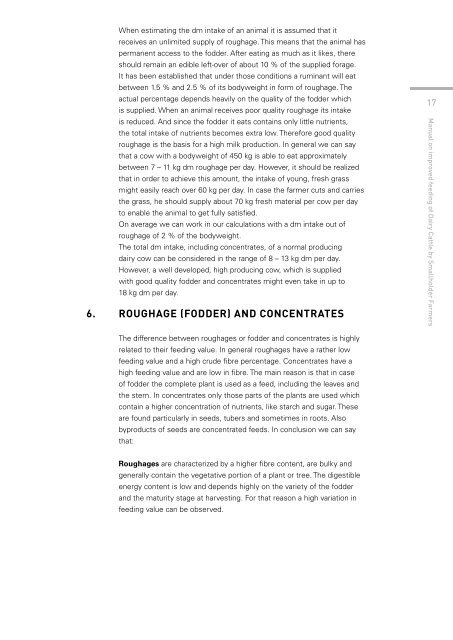MANUAL ON IMPROVED FEEDING OF DAIRY CATTLE BY ... - Gart
MANUAL ON IMPROVED FEEDING OF DAIRY CATTLE BY ... - Gart
MANUAL ON IMPROVED FEEDING OF DAIRY CATTLE BY ... - Gart
You also want an ePaper? Increase the reach of your titles
YUMPU automatically turns print PDFs into web optimized ePapers that Google loves.
When estimating the dm intake of an animal it is assumed that it<br />
receives an unlimited supply of roughage. This means that the animal has<br />
permanent access to the fodder. After eating as much as it likes, there<br />
should remain an edible left-over of about 10 % of the supplied forage.<br />
It has been established that under those conditions a ruminant will eat<br />
between 1.5 % and 2.5 % of its bodyweight in form of roughage. The<br />
actual percentage depends heavily on the quality of the fodder which<br />
is supplied. When an animal receives poor quality roughage its intake<br />
is reduced. And since the fodder it eats contains only little nutrients,<br />
the total intake of nutrients becomes extra low. Therefore good quality<br />
roughage is the basis for a high milk production. In general we can say<br />
that a cow with a bodyweight of 450 kg is able to eat approximately<br />
between 7 – 11 kg dm roughage per day. However, it should be realized<br />
that in order to achieve this amount, the intake of young, fresh grass<br />
might easily reach over 60 kg per day. In case the farmer cuts and carries<br />
the grass, he should supply about 70 kg fresh material per cow per day<br />
to enable the animal to get fully satisfied.<br />
On average we can work in our calculations with a dm intake out of<br />
roughage of 2 % of the bodyweight.<br />
The total dm intake, including concentrates, of a normal producing<br />
dairy cow can be considered in the range of 8 – 13 kg dm per day.<br />
However, a well developed, high producing cow, which is supplied<br />
with good quality fodder and concentrates might even take in up to<br />
18 kg dm per day.<br />
6. ROUGHAGE (FODDER) AND C<strong>ON</strong>CENTRATES<br />
The difference between roughages or fodder and concentrates is highly<br />
related to their feeding value. In general roughages have a rather low<br />
feeding value and a high crude fibre percentage. Concentrates have a<br />
high feeding value and are low in fibre. The main reason is that in case<br />
of fodder the complete plant is used as a feed, including the leaves and<br />
the stem. In concentrates only those parts of the plants are used which<br />
contain a higher concentration of nutrients, like starch and sugar. These<br />
are found particularly in seeds, tubers and sometimes in roots. Also<br />
byproducts of seeds are concentrated feeds. In conclusion we can say<br />
that:<br />
Roughages are characterized by a higher fibre content, are bulky and<br />
generally contain the vegetative portion of a plant or tree. The digestible<br />
energy content is low and depends highly on the variety of the fodder<br />
and the maturity stage at harvesting. For that reason a high variation in<br />
feeding value can be observed.<br />
17<br />
Manual on improved feeding of Dairy Cattle by Smallholder Farmers


